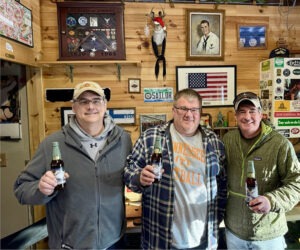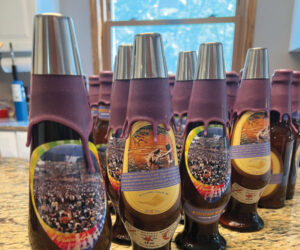Girl Power

“As beer became more commercial, and widely available as packaged goods, taverns became more male-centric, and the image of the beer drinker became more that of the working man,” says Nancy Rigberg, co-owner of Home Sweet Homebrew in Philadelphia. “Bars were less welcoming to women, relegating them to the ‘ladies entrance.’”
Even though female brewers and brewery employees are steadily increasing in the last decade and women craft beer enthusiasts are in abundance, homebrewing still remains a male-dominated activity.
The American Homebrewers Association (AHA) says women make up only 13 percent of their membership. (Although, they believe it’s closer to 25 percent, with male members brewing with a female significant other.) The owner of HomebrewAcademy.com estimates his audience is only 7 percent women. So we ask, why aren’t more women homebrewing?
Many point to marketing as the culprit to a lack of participation amongst women. Millie Shamburger, American Homebrewers Association Business Programs Coordinator, says beer has been consistently marketed to men with sexist advertising for a long time. “The image of the bearded, beer-bellied males, or women just as the props in commercials, takes time to break down,” says Shamburger.
Besides the advertising clearly geared towards men, some attribute the lack of women pursuing the hobby to not having a welcoming experience in the homebrew community, whether it being at a local store or a homebrew club. There could also be hesitation if a woman feels she doesn’t have support or someone to talk to about homebrewing, says Jeanne Burns, Vice President of DC Homebrewers.
Whatever the reason for the lack of diversity in homebrewing, there is a plethora of steps to be taken to bridge the gap.
The Part Homebrew Stores Play
The journey for many homebrewers starts at the store, which could be a pivotal moment for any newbie. While it’s generally Business 101 – treat all of your customers with respect — unfortunately some stores have fallen short of this in the past. Homebrew stores need to welcome a woman (and all customers) in the shop without talking down to her or trying to impress her with knowledge, Shamburger says. “Don’t assume that a woman who comes into the shop is shopping for a spouse or isn’t knowledgeable about homebrewing,” she says.
Her advice continues with, “Don’t brush them off if a guy comes in to buy stuff, too. Don’t assume that women want to make ‘chick beers.’ And, if they want to make a fruit beer, don’t assume it’s because they don’t like other beers.”
Homebrew stores need to be authentic in their support of women, says Denise Ratfield, Director of the International Women’s Collaboration Brew Day (IWCBD). “Shop owners, ask yourself: Is your store a friendly environment to all who walk in or shop online? Are your staff engaging female consumers the same as they do men?” Ratfield says. “Word of mouth goes a long way. A customer will tell others about how great or dismal their experience was at the store.”
The Editor-in-Chief and Owner of HomeBrewAcademy.com, Billy Broas, suggests one thing homebrew stores can do is create how-to videos and other content that feature women. “It’s not a man’s hobby for any reason other than men seem to be attracted to it,” he says.
Brewmented, a homebrew store in Longmont, Colorado, changed the playbook to create an entirely different shop experience for all, including women. “Staffing is a huge part of making women feel more comfortable,” says Co-Owner Bill Campbell. He hired Kitty Vant, a female homebrewer with a decade of experience in the industry, as the store’s general manager as well as other enthusiastic female staff. “Some women may feel more comfortable approaching another woman with their questions,” Vant says.
Vant not only manages the store, but she also teaches women-only how to brew courses right in the store at no cost. “I’ve noticed women-only classes are really social,” Vant explains of a recent event. “Women seemed more comfortable here and quickly introduced themselves to each other.” Overall, she describes the experience as a truly positive event.
The importance of women-only courses, ideally taught by a woman, is echoed amongst both men and women in the craft beer industry. It takes away some of the potential intimidation that some women may feel and allows for a more welcoming environment to ask questions and meet fellow female homebrewers.
But Campbell isn’t stopping there. The entire space and atmosphere of the store isn’t of the traditional homebrew shop and is meant to appeal to not only women, but all first-time homebrewers. “The hope is for the store to be a destination and a place to gather,” Campbell explains. “Not just a place to buy ingredients.”
The large, bright, clean space is home to ample seating in the back along with several local taps, including their own brews. This allows for shoppers to grab a beer and have no rush while browsing. Besides a beginner’s women’s-only brew course, there’s also a free women’s-only intro to all-grain brewing class. In addition to the classes, they’ve hosted bands for live music, speakers on the history of beer, and beer and cheese pairings. These events draw people in who may not have otherwise visited a homebrew store, Campbell explains. Vant opts to keep the tap list eclectic so she can help anyone who comes in navigate to a style that suits her or his palate.
Anne Duany Whyte, Owner of Vermont Homebrew Supply, has added activities to keep children busy so entire families can take part in the shopping experience. “We are a small store. We keep a crate of toys for the little brewers. It helps to give mom and dad time to put a recipe together and chat,” she says.
Megan Henslick, co-owner of Renegade Brewing Supplies in Turlock, California with her husband Luke, says that while women deserve attention from staff, they don’t appreciate feeling like a gimmick or an oddity when they walk into a homebrew store. “I once had the opportunity granted to me to brew on a commercial system as long as the brewery could market the beer as ‘brewed by a woman for women,’” says Henslick. “I did not like the experience, and I do my best to not make other women feel as I did,” Henslick says.
She is trying to increase her female customer base, which is at 5 percent, by offering free advice and classes as well as open forums on her social media outlets. They let anyone, whether a customer or not, bring their beer in for troubleshooting.
For Jennifer Misfeldt, co-owner of Patriot Homebrew Supply in Elkhorn, Nebraska, it’s important for her to spread the word on the female homebrew community in her store. She posts flyers in the store of any nearby women brewing events and contests as well as readily shares the information for the local women-only homebrew club to any females that come into the store. Even though only 10 percent of her customers are female, she is all about creating an even playing field for anyone in the store. “When a couple walks into the store, I make sure that our dialog includes the woman in attendance, and I make the assumption they are a part of the process at home, too,” Misfeldt says.
Janna Williams, Co-owner of CO BREW in Denver, says the opportunity for people to brew on-site has allowed several groups of women to give homebrewing a whirl, including bachelorette parties, girls’ night out, professional networking events, and more. The store is currently participating in the Women-Only Craft Brewery Tour, organized by Laura Bruns at Factotum Brewhouse. “This is an exciting opportunity for women who are interested in craft beer to meet with the female owners of several breweries to hear their stories and ask questions,” Williams says. She says that brewing beer, just like starting any other hobby, can be intimating. To ease this anxiety, Williams offers free tools on her store’s website, such as recipe calculators, conversion charts, and substitution lists, which is beneficial to all newcomers, regardless of sex.
Women-only classes and events have shown to be successful in expanding the hobby to women, but sexism in the hobby — whether intentional or not — will take time to break. And it isn’t just new customers — female storeowners often experience it firsthand, and are doing what they can to change it.
“Don’t assume the woman working in the store doesn’t know anything about brewing. I encounter this all the time. Folks walk in, look at me, my husband or my son, and direct the questions to them. It doesn’t take long for this to be rectified, but sexism in brewing is very real. Younger men are just as guilty as older men. And sadly, women make the same assumptions when they walk in,” says Whyte. “Side note: No one ever asks my husband if he brews. I get asked quite often.”
Creating a Community
Making women feel comfortable in the world of homebrewing doesn’t stop at the store. Homebrew clubs also play an integral role in creating a positive experience for both existing and new female homebrewers.
A great example of a group doing it right is the Washington DC Homebrewers, who created the subgroup HOPS (Homebrew Outreach and Participation Sisterhood). The goal is to help educate women about homebrewing and to build a community of women homebrewers, says Jeanne Burns, committee co-chairperson. “It was created with the hopes of increasing women’s participation in a hobby dominated by males,” says Burns.
It’s not just about creating a separate space for women, but clubs should also focus on making the existing co-ed space more welcoming. “I feel that mentorship by women that have been homebrewing awhile can be a great way to encourage those ladies that are just starting out,” Burns adds.
Clubs could consider allowing a membership to include the entire home, which can encourage participation among spouses as well. The Bloatarian Brewing League, a Cincinnati-based club, does just that.
Another idea for clubs is to invite women brewers or women in the industry to speak at club meetings. Or take a page from events like Queen of Homebrew and SheBrew to create a female-only homebrew competition.
The advice to male club members is if you see a new female face, or any new face for that matter, introduce yourself and say hello. Invite a female friend to come along to see if homebrewing is something that interests her. To existing female club members, bring along a friend and consider taking on a mentorship role to newcomers.
It Starts at the Top
The female participation in brewing programs at UC-Davis has been on the rise in recent years. Melissa Marbach, the Professional Brewing Programs Representative at UC-Davis feels this increase is in part due to a slow but steady acceptance of women in the industry as a whole.
“I attribute the interest to the explosion of the craft brewing industry and the women who blazed a trail for those of us who came after. Because of these women, it’s clear that the brewing industry has space for both males and females,” Marbach says.
AHA’s Shamburger says women seeing more professional brewers at their local breweries and more women working in the industry can create more female curiosity in brewing on their own.
“The more we can see images of women in brewing roles, in real life with craft beer, brewing at Big Brew, attending club meetings, being in leadership positions, the more chance we have of pulling more women in,” she says.
The advice to breweries is include photos of your female employees on social media and marketing pages. If there aren’t women in brewing, production, and leadership positions, consider why that is. Highlighting women in professional roles at a brewery can lead to more women in homebrewing.
Besides on a professional level, it’s important for a tap room and a beer bar’s environment to be an unpretentious, relaxed environment, which sadly oftentimes it is not. Shamburger advises brewery and bar management to talk to the staff about paying equal attention to men and women.
Make sure your servers aren’t making assumptions about a woman’s beer preference. If a woman is new to craft beer, don’t just suggest a “girl beer.” Find out what flavors she usually enjoys, such as coffee, wine, chocolate, sweet drinks, and so on. Show your taproom’s diversity in the photos you post to social media.
The rise of female-focused beer events and organizations also creates a step in the right direction for women in homebrewing and in the craft beer industry as a whole.
FemAle Brew Fest features breweries from around the country that are either owned or run by women or have women in a production role, such as a brewer, cellar woman, or a quality role. Along with the breweries, the event also features a female DJ and female-led bands.
Founder of the event, Frances Antonio-Martineau, is thrilled that the fest grew from 15 breweries last year to 26 in its second year. “I think that just like any male-dominated industry, there is always an intimidation factor that goes into play. But with organizations like the Pink Boots Society and events like FemAle, it is shining a light on the women doing amazing things in the industry,” Antonia-Martineau says. Just in the last couple of years of producing the festival, she has seen a number of women not only drinking more beer but also showing an interest in getting into the industry.
International Women’s Collaboration Brew Day is another empowering event that encourages women to brew. It started as a way to raise awareness of women brewers in the industry and bring beer to female consumers. The goal is to get women together to brew and encourage an exchange of ideas and camaraderie. The day skyrocketed with annual participants not only all over the United States, but in Iceland, South Africa, and beyond. Denise Ratfield said that the day didn’t only impact professional women in the industry, but caught on amongst female homebrewers, too.
“We had women posting from their kitchens, garages, and backyards, brewing solo and with their friends,” says Ratfield. “It was a natural progression to include homebrewers as official participants and encourage their growth.”
While there are plenty of stories of people focusing on a female’s male counterpart when walking into a homebrew store or assuming a woman prefers wine, generally, the brewing community is a good one to join. Female homebrewer Alesandra Woolley says while she definitely feels outnumbered as a woman, she doesn’t feel excluded.
“Whenever we attend homebrew competitions or events, there are certainly fewer women than men, but the amount of women attending these types of events grows every year,” she says.
For the women out there, hesitant to get started in homebrewing, there’s no better time than now. With countless great homebrewing books, online resources, and homebrew stores being more responsive than ever, you can start creating your own masterpiece. Seek out your local women’s homebrewing group or other women in existing co-ed groups. “Seek out other women at homebrew clubs,” Burns says. “Although largely outnumbered, we are there!”



